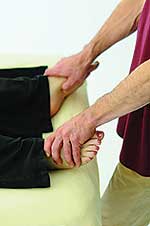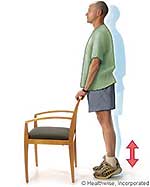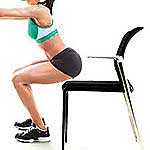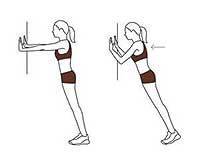Is Push Therapy for You?
by Cactus Moloney
|
Drew Roots discussed Push Therapy and his own story from trauma to treatment in a free class at Moonflower Coop.
Roots told the story of his childhood misfortune. He was a weak soft and pudgy kid, raised on an unhealthy diet.
In seventh grade he wasn’t able to do a pull up.
“That was a real blow,” he said. The physical education teacher gave him the white patch to wear on his shorts, advertising he was the weakest in the class, he said, “It was traumatic.”
Roots started weight lifting and bulked up, but in the process created muscle imbalances. His posture continued to get worse, his shoulders rounded, his body was tight and he suffered back spasms.
Later Roots attended Massage School and learned about those muscle imbalances. He would tell clients that he was “naturally tight.” Later he learned this not to be the case. Being tight is a function of stress, diet and physical “things you have done in life.”
Since learning Push Therapy Roots is looser with improved posture now that he is aligned and using his core properly.
“I’m taller,” he said, “I’ve grown a whole inch.”
Push Therapy is a functional fitness program that helps the body move fluidly.
 It is a cultural mindset that more exercise is better; in the case of yoga, flexibility can become a liability It is a cultural mindset that more exercise is better; in the case of yoga, flexibility can become a liability
.
People train in tension when they are working out. They might push through the weight, but the body is tense the whole time. Lifting on top of tight muscles can make it worse.
“The absence of pain doesn’t mean the absence of tension,” Roots said.
In order to see the benefits of Push Therapy a coach is needed to help with core exercises, so you don’t build more tension.
Roots chose one lucky guinea-pig for a coaching exercise. The coaching went something like this: pretend a banana goes in your stomach and out your pelvis, don’t bend your back, settle the shoulders, let the legs burn a little more than you like to release tension, parallel feet, banana gut, bend knees, round back out, curl tailbone, bend at the waste, back on heals, suck in guts.
During the exercise the legs will start to burn; this is a precursor to shaking, keep reengaging the legs. The shaking releases the tension, he said. When the core is no longer engaged the exercise can be stopped.
Roots said that Push Therapy works 85% of the time; some notice a difference after the first session. However, Roots suggests that you continue sessions so the weak muscle memory will not return.
“People think, I guess I’m hurting and that is the way life is,” Roots said.
Push Therapy might be the answer.
|
 October is National Physical Therapy month and I wanted to take the time to encourage our senior population to get up and move. The more sedentary your lifestyle the higher your risk of disease and infection. Simple exercises that involve weight bearing can improve your health and bone density. As we age it is easier to slow down and lose motivation to exercise. The first thing you should do is ask a friend to be your exercise partner; you can use this person to discuss exercise goals with. An exercise partner can be someone you enjoy cooking with to prepare healthy meals. When you are standing and chopping or reaching and bending in the kitchen while cooking- this is weight bearing exercise. If you are more active, start a walking program with your exercise partner. Start slow with short distances and build up to longer routes as tolerated for an ultimate goal of 30 minutes per day at least five days per week. October is National Physical Therapy month and I wanted to take the time to encourage our senior population to get up and move. The more sedentary your lifestyle the higher your risk of disease and infection. Simple exercises that involve weight bearing can improve your health and bone density. As we age it is easier to slow down and lose motivation to exercise. The first thing you should do is ask a friend to be your exercise partner; you can use this person to discuss exercise goals with. An exercise partner can be someone you enjoy cooking with to prepare healthy meals. When you are standing and chopping or reaching and bending in the kitchen while cooking- this is weight bearing exercise. If you are more active, start a walking program with your exercise partner. Start slow with short distances and build up to longer routes as tolerated for an ultimate goal of 30 minutes per day at least five days per week.
Here is a list of simple daily exercises designed to encourage better bone health and strength:
** If you have been sedentary please consult your primary care physician before beginning any exercise routine. If you are on multiple medications, have hearing or vision loss you may be at higher risk of falls- please seek the advice of a physical therapist  before starting any exercises suggested in this article. before starting any exercises suggested in this article.
Beginner Daily Routine: Pick a standing activity for 15 min (cooking, cleaning, bird watching, singing)
Indoor standing options:
Heel raise x 15 x 2 sets (sit and rest between sets). Start standing and press through your toes and raise your heels off the floor as high as you safely can while holding onto the back of a counter for support if needed. Slowly lower heels back down and repeat.
Mini squats x 15 x 2 sets. While holding onto a table with chair behind you squat down (without sitting all the way down) and then straighten your legs and stand back up. As you get stronger try to squat even lower and then stand back up.
 Wall Pushup x 15 x 2 sets. Standing arm’s length away from the wall allow your elbows to bend and chest to move toward the wall slowly, then push through palm of your hands and straighten your arms. Wall Pushup x 15 x 2 sets. Standing arm’s length away from the wall allow your elbows to bend and chest to move toward the wall slowly, then push through palm of your hands and straighten your arms.
Please take the time to write down a weekly goal aimed to “KEEP YOU MOVING”. What will your goal be? For more advanced exercises please call Moab Physical Therapy (435) 210-1985 and schedule an evaluation with our Physical Therapist, Rhonda Cowern to address your movement goals. Please read our success stories at www.moabphsycialtherapy.com and follow us on Facebook and Twitter!
|

 It is a cultural mindset that more exercise is better; in the case of yoga, flexibility can become a liability
It is a cultural mindset that more exercise is better; in the case of yoga, flexibility can become a liability October is National Physical Therapy month and I wanted to take the time to encourage our senior population to get up and move. The more sedentary your lifestyle the higher your risk of disease and infection. Simple exercises that involve weight bearing can improve your health and bone density. As we age it is easier to slow down and lose motivation to exercise. The first thing you should do is ask a friend to be your exercise partner; you can use this person to discuss exercise goals with. An exercise partner can be someone you enjoy cooking with to prepare healthy meals. When you are standing and chopping or reaching and bending in the kitchen while cooking- this is weight bearing exercise. If you are more active, start a walking program with your exercise partner. Start slow with short distances and build up to longer routes as tolerated for an ultimate goal of 30 minutes per day at least five days per week.
October is National Physical Therapy month and I wanted to take the time to encourage our senior population to get up and move. The more sedentary your lifestyle the higher your risk of disease and infection. Simple exercises that involve weight bearing can improve your health and bone density. As we age it is easier to slow down and lose motivation to exercise. The first thing you should do is ask a friend to be your exercise partner; you can use this person to discuss exercise goals with. An exercise partner can be someone you enjoy cooking with to prepare healthy meals. When you are standing and chopping or reaching and bending in the kitchen while cooking- this is weight bearing exercise. If you are more active, start a walking program with your exercise partner. Start slow with short distances and build up to longer routes as tolerated for an ultimate goal of 30 minutes per day at least five days per week. before starting any exercises suggested in this article.
before starting any exercises suggested in this article. Wall Pushup x 15 x 2 sets. Standing arm’s length away from the wall allow your elbows to bend and chest to move toward the wall slowly, then push through palm of your hands and straighten your arms.
Wall Pushup x 15 x 2 sets. Standing arm’s length away from the wall allow your elbows to bend and chest to move toward the wall slowly, then push through palm of your hands and straighten your arms.